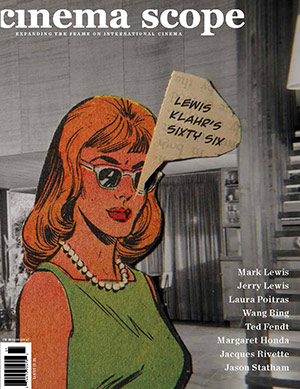 For Cinema Scope
issue number sixty-six a beautiful still from Lewis Klahr’s Sixty Six graces its cover. In its annual, though perhaps begrudgingly,
tradition of organizing a top ten list with its contributors (to be eligible
they must have contributed to each of its quarterly issues) the elected
titles combined tend to offer a representative survey of the major films and
the new cinematographic trends of that previous year. Perhaps to celebrate this new
issue, and with the pass of the half-way mark of the 2010 decade, it’s as good a
time as any to look back and reflect on these lists, going as far back as 2010. These lists for the 2015 to 2010 years appear in the issues number sixty-six, sixty-two, fifty-eight, fifty-four, fifty and forty-six.
This would provide a broader view of the cinematographic preferences of the
magazine, the directors that they feature, their average age, and the countries that
they’re from – essentially what constitute the creators of the most exciting films of this period.
For Cinema Scope
issue number sixty-six a beautiful still from Lewis Klahr’s Sixty Six graces its cover. In its annual, though perhaps begrudgingly,
tradition of organizing a top ten list with its contributors (to be eligible
they must have contributed to each of its quarterly issues) the elected
titles combined tend to offer a representative survey of the major films and
the new cinematographic trends of that previous year. Perhaps to celebrate this new
issue, and with the pass of the half-way mark of the 2010 decade, it’s as good a
time as any to look back and reflect on these lists, going as far back as 2010. These lists for the 2015 to 2010 years appear in the issues number sixty-six, sixty-two, fifty-eight, fifty-four, fifty and forty-six.
This would provide a broader view of the cinematographic preferences of the
magazine, the directors that they feature, their average age, and the countries that
they’re from – essentially what constitute the creators of the most exciting films of this period.
Excluding
their yearly special mentions, all of the films that made their top ten lists
so far (since 2010) include (in alphabetical order): A Touch of
Sin, Adieu au langage, Arabian Nights, Attenberg, autrement, la Molussie,
Cemetery of Splendour, Computer Chess, Django Unchained, Dreileben, Film
Socialisme, From What Is Before, Holy Motors, Horse Money, I Wish I Knew,
Inherent Vice, Inside Llewyn Davis, It’s the Earth Not the Moon, Jauja, Journey
to the West, Kaili Blues, Kill List, L'Apollonide: Souvenirs de la maison
close, L’inconnu du lac, Le gamin au vélo, Leviathan, Lost and Beautiful,
Maidan, Meek’s Cutoff, Moonrise Kingdom, Mysteries of Lisbon, Neighboring
Sounds, No Home Movie, Norte, the End of History, Once Upon a Time in Anatolia,
P’tit Quinquin, Phoenix, Right Now, Wrong Then, Sleeping Sickness, Story of My
Death, Stray Dogs, Tabu, The Assassin, The Autobiography of Nicolae Ceaușescu,
The Forbidden Room, The Ghost Writer, The Kindergarten Teacher, The Last Time I
Saw Macao, The Master, The Strange Case of Angelica, The Strange Little Cat,
The Treasure, The Tree of Life, The Turin Horse, The Wolf of Wall Street, This
is Not a Film, Uncle Boonmee Who Can Recall His Past Lives, Viola, Visit, or
Memories and Confessions, What Now? Remind Me, Winter Vacation.
For the sake of neatness the following summary might include
a few helpful generalizations: where the director might have associations with
more than one country, the specific country of the film or which they are more
identified with will be highlighted (e.g. Godard and Paravel with France,
Loznitsa with Ukraine, da Mata with Portugal, and Zürcher with Germany). Manoel
de Oliveira made Visit, or Memories and
Confessions when he was eighty-three so it would be inputted at that age.
And when the directors work in pairs or with the inclusion of an omnibus film,
each of the individuals would be properly inputted (which might lead to
potential over-representation).
The directors who reoccur on these lists, all with a maximum
of two inclusions, are: Apichatpong Weerasethakul (Cemetery of Splendour, Uncle Boonmee Who Can
Recall His Past Lives), Christian Petzold
(Phoenix, Dreileben), Jean-Luc
Godard (Adieu au langage, Film
Socialisme), Jia Zhangke (A Touch of
Sin, I Wish I Knew), Lav Diaz (From
What Is Before, Norte, the End of History), Manoel de Oliveira (Visit, or Memories and Confessions, The
Strange Case of Angelica), Miguel Gomes (Arabian Nights, Tabu), Paul Thomas Anderson (Inherent Vice, The Master), Tsai Ming-liang (Journey to the West, Stray Dogs). That some directors don’t
(re-)appear more frequently on these lists during this six year period might have more to do with the precariousness of producing these more challenging type of films and
certain curating trends of the film festival circuit.
Of the
sixty-eight directors on the list: fifteen of them are under the age of forty,
twenty-two of them are in their forties, twenty-four of them are between fifty
and seventy, and the remaining six of them are older than seventy.
The most reoccurring countries are the United States (with eleven
titles), Portugal (with nine titles), France (with eight titles), Germany (with
six titles), China (with four titles), and so on.
One of the great film magazines, a convergence point for contemporary
cinematographic trends, and always an interesting and stimulating read. Here’s
to a good 2016 year for Cinema Scope!


No comments:
Post a Comment